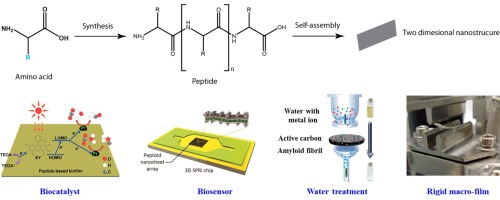当前位置:
X-MOL 学术
›
Nano Today
›
论文详情
Our official English website, www.x-mol.net, welcomes your
feedback! (Note: you will need to create a separate account there.)
Two-dimensional peptide based functional nanomaterials
Nano Today ( IF 13.2 ) Pub Date : 2018-12-01 , DOI: 10.1016/j.nantod.2018.10.008 Lei Liu , Lasse Hyldgaard Klausen , Mingdong Dong
Nano Today ( IF 13.2 ) Pub Date : 2018-12-01 , DOI: 10.1016/j.nantod.2018.10.008 Lei Liu , Lasse Hyldgaard Klausen , Mingdong Dong

|
Abstract Polypeptides and proteins have a high density of chemical functionality, which can be used to construct defined macromolecular nano architectures, such as low dimensional assemblies (i.e., nanoparticles, nanofibers and nanotubes), two-dimensional nanosheets, and extended three-dimensional structures (i.e., crystalline solids). Two-dimensional nanosheets are a fundamentally important geometry that bridges the gap between low dimensional assemblies and three-dimensional structures. In view of the considerable impact on a great many fundamental and applied aspects of biological and material sciences, it is therefore significant and valuable to review the recent works related to this field. In recent years, a central goal is to design novel materials with molecular-level information that can be utilized to direct highly specific intra- and intermolecular interactions promoting self-assembly of thermodynamically stable and structurally defined two-dimensional (2D) assemblies. In this review, we present a variety of strategies for constructing the 2D nanoscale assemblies and nanomaterials using specific interactions of polypeptides or similar peptoid molecules in a well-predictable manner. These controllable 2D nanomaterials can also display a variety of functionalities. Initially, the primary and secondary structure of peptides will be introduced. Examples of controlled fabrication of two-dimensional assemblies on the nanoscale are subsequently presented based on different secondary structures of the peptides, e.g. two-dimensional crystals from α-helix, nanoscale sheets from self-assembly of collagen-mimetic peptides with triple helix, co-assembled nanosheet structures assembled from peptide-organic molecules with β-strand conformation, and 2D crystals assembled from peptoid with Σ-strand structure. Furthermore, macrofilms assembled from protein fibril arrays are introduced. These bottom-up strategies can arrange polypeptides and proteins into well-ordered 2D structures, which can have wide-ranging applications, such as membrane-based separations with specific mechanical properties, the control of surface properties in nanodevice and nanosensor fabrication, retroviral transduction in biology and diagnosis of some disease in biomedicine.
中文翻译:

基于二维肽的功能纳米材料
摘要 多肽和蛋白质具有高密度的化学功能,可用于构建确定的大分子纳米结构,如低维组装(即纳米颗粒、纳米纤维和纳米管)、二维纳米片和扩展的三维结构(即结晶固体)。二维纳米片是一种基本重要的几何形状,它弥合了低维组件和三维结构之间的差距。鉴于对生物和材料科学的许多基础和应用方面的重大影响,因此回顾最近与该领域相关的工作具有重要意义和价值。最近几年,一个中心目标是设计具有分子级信息的新型材料,可用于指导高度特异性的分子内和分子间相互作用,促进热力学稳定和结构定义的二维 (2D) 组装的自组装。在这篇综述中,我们提出了各种使用多肽或类似拟肽分子的特定相互作用以可预测的方式构建二维纳米级组件和纳米材料的策略。这些可控的二维纳米材料还可以显示多种功能。最初,将介绍肽的一级和二级结构。随后基于肽的不同二级结构,在纳米尺度上控制制造二维组件的例子,例如 来自α-螺旋的二维晶体,来自具有三螺旋的胶原模拟肽自组装的纳米级片,由具有β-链构象的肽-有机分子组装的共组装纳米片结构,以及由具有Σ-的拟肽组装的二维晶体链结构。此外,还介绍了由蛋白质原纤维阵列组装的宏膜。这些自下而上的策略可以将多肽和蛋白质排列成有序的 2D 结构,具有广泛的应用,例如具有特定机械特性的基于膜的分离、纳米器件和纳米传感器制造中的表面特性控制、逆转录病毒转导生物医学中某些疾病的生物学和诊断。由具有 β 链构象的肽-有机分子组装而成的共组装纳米片结构,以及由具有 Σ 链结构的类肽组装而成的二维晶体。此外,还介绍了由蛋白质原纤维阵列组装的宏膜。这些自下而上的策略可以将多肽和蛋白质排列成有序的 2D 结构,具有广泛的应用,例如具有特定机械特性的基于膜的分离、纳米器件和纳米传感器制造中的表面特性控制、逆转录病毒转导生物医学中某些疾病的生物学和诊断。由具有 β 链构象的肽-有机分子组装而成的共组装纳米片结构,以及由具有 Σ 链结构的类肽组装而成的二维晶体。此外,还介绍了由蛋白质原纤维阵列组装的宏膜。这些自下而上的策略可以将多肽和蛋白质排列成有序的 2D 结构,具有广泛的应用,例如具有特定机械特性的基于膜的分离、纳米器件和纳米传感器制造中的表面特性控制、逆转录病毒转导生物医学中某些疾病的生物学和诊断。
更新日期:2018-12-01
中文翻译:

基于二维肽的功能纳米材料
摘要 多肽和蛋白质具有高密度的化学功能,可用于构建确定的大分子纳米结构,如低维组装(即纳米颗粒、纳米纤维和纳米管)、二维纳米片和扩展的三维结构(即结晶固体)。二维纳米片是一种基本重要的几何形状,它弥合了低维组件和三维结构之间的差距。鉴于对生物和材料科学的许多基础和应用方面的重大影响,因此回顾最近与该领域相关的工作具有重要意义和价值。最近几年,一个中心目标是设计具有分子级信息的新型材料,可用于指导高度特异性的分子内和分子间相互作用,促进热力学稳定和结构定义的二维 (2D) 组装的自组装。在这篇综述中,我们提出了各种使用多肽或类似拟肽分子的特定相互作用以可预测的方式构建二维纳米级组件和纳米材料的策略。这些可控的二维纳米材料还可以显示多种功能。最初,将介绍肽的一级和二级结构。随后基于肽的不同二级结构,在纳米尺度上控制制造二维组件的例子,例如 来自α-螺旋的二维晶体,来自具有三螺旋的胶原模拟肽自组装的纳米级片,由具有β-链构象的肽-有机分子组装的共组装纳米片结构,以及由具有Σ-的拟肽组装的二维晶体链结构。此外,还介绍了由蛋白质原纤维阵列组装的宏膜。这些自下而上的策略可以将多肽和蛋白质排列成有序的 2D 结构,具有广泛的应用,例如具有特定机械特性的基于膜的分离、纳米器件和纳米传感器制造中的表面特性控制、逆转录病毒转导生物医学中某些疾病的生物学和诊断。由具有 β 链构象的肽-有机分子组装而成的共组装纳米片结构,以及由具有 Σ 链结构的类肽组装而成的二维晶体。此外,还介绍了由蛋白质原纤维阵列组装的宏膜。这些自下而上的策略可以将多肽和蛋白质排列成有序的 2D 结构,具有广泛的应用,例如具有特定机械特性的基于膜的分离、纳米器件和纳米传感器制造中的表面特性控制、逆转录病毒转导生物医学中某些疾病的生物学和诊断。由具有 β 链构象的肽-有机分子组装而成的共组装纳米片结构,以及由具有 Σ 链结构的类肽组装而成的二维晶体。此外,还介绍了由蛋白质原纤维阵列组装的宏膜。这些自下而上的策略可以将多肽和蛋白质排列成有序的 2D 结构,具有广泛的应用,例如具有特定机械特性的基于膜的分离、纳米器件和纳米传感器制造中的表面特性控制、逆转录病毒转导生物医学中某些疾病的生物学和诊断。











































 京公网安备 11010802027423号
京公网安备 11010802027423号